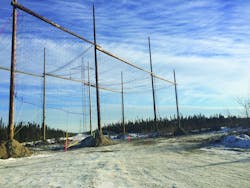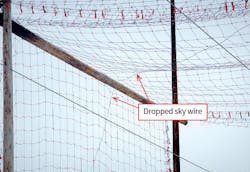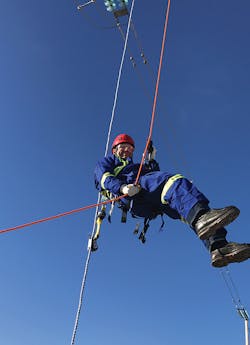Live-Line Crews Improve Safety with Dielectric Nets
Flashover incidents involving fiberglass-reinforced plastic (FRP) tools, which occurred in 1997 and 2002 at Manitoba Hydro, put a sudden stop to live-line maintenance work for more than a decade. In 2013, Manitoba Hydro returned to live-line maintenance work at 500-kV AC/DC with renewed interest and with a work plan focusing on handling, maintenance and testing of FRP tools.
As part of the new program, Manitoba Hydro has implemented recent measures such as paying close attention to weather restrictions, retraining junior staff, enhancing in-field supervision and using polymer sheds. The utility’s primary objective is to ensure all the crucial elements are in place to exceed current industry standards or best practices related to live-line methods and tools, and to establish a new Gold Standard for such operations.
Using Rope Safety Netting
Manitoba Hydro is presently building the Bipole III, a 1400-km-long, 500-kV transmission line to transport hydroelectricity from the north of the province to the south to supply customer load and export added capacity. The construction of the line and chosen route has resulted in the need for up to 50 transmission line crossings over existing energized lines having voltages of 66 kV or greater.
When performing live-line work, workers must have special tools, methods and training not only to work safely on energized lines, but also to allow their utilities to carry on business as usual without interruption of service. For example, to cross over existing energized transmission lines, Manitoba Hydro uses a technique consisting of rider poles and rope nets. This method allows for a safely protected crossing over energized transmission lines and also can serve to cross over roads, railway and over energized apparatus in a station environment.
In the eventuality of a mechanical failure of a clamp holding a conductor or sky wire, the falling line is caught into the net and is prevented from sagging uncontrollably into energized phases, thereby avoiding major safety issues, outages and other hazards for the public and workers below. The rider pole structures are versatile, fast and easy to erect, and can withstand most weather conditions. They may be used to span short or long distances and can be erected in a multitude of configurations.
Evaluating Options
During an initial assessment of netting options for the multiple crossings of the Bipole III transmission lines, the only existing options consisted of conventional synthetic rope or webbing. Such materials had serious drawbacks that needed to be evaluated as their dielectric reliability was marginal. For example, once installed, they could be exposed to dust and moisture, which could remain trapped inside the woven fibers. This meant that the dielectric properties of the net would be significantly reduced, which could create a potentially dangerous risk for the linemen handling the net.
Although some of these materials may pass dielectric testing when new and dry, they rapidly lose their dielectric properties when wet or dirty. Their reliability cannot be demonstrated once installed and exposed to the environment or after storage from previous use.
Testing Ropes
Industry standards for live working and insulating ropes, such as IEC 62192 and ASTM F1701 rope testing standards, are stringent, especially for the wet testing part, and very few ropes meet the requirements of both standards. However, the requirements for these rope standards are not as strict as the requirements for the maintenance and care of tools and equipment used in the vicinity of energized lines tools per the IEEE 516 standard. For example, the IEEE 516 standard allows only a few micro amps of current during a wet test on an FRP tool, while the IEC and ASTM rope standards allow for hundreds of microamps. It also should be noted that these rope standards specify that the wet test voltage stress be reduced by half when compared to the dry test voltage and the FRP standards.
To ensure the integrity of all live-line tools, it is necessary to perform a prior-to-use field test on rope or FRP tools. Field testing equipment for rope has not been well adapted or proven to be reliable. Conventional ropes typically offered for live-line work are made of synthetic fibers, which are either braided or twisted. The dielectric testing results are only valid for new, unused and clean rope. This conventional rope type cannot be readily cleaned or dried, and the open fibers may trap embedded dust or moisture once exposed to working conditions in the field. Thus, they may become rapidly contaminated and lose their new-state dielectric properties.
Searching for New Technology
Based on Manitoba Hydro’s earlier experience of FRP hot-stick flashovers and the knowledge that these flashovers were due to light surface contamination and moisture, improvements on rope products were sought out. Other reported incidents have occurred throughout the industry whereby wet or contaminated ropes, which were in contact with energized phases, have resulted in hazardous currents for workers handling the rope and near-misses of serious injury.
Manitoba Hydro approached Barry Cordage Ltd. (Barry) of Montreal, Canada, based on the company’s extensive experience with dielectric rope products. Barry had developed unique dielectric ropes used for live-line stringing of optical ground wire (OPGW) two decades ago for a Hydro-Québec project, which had enabled work on 735-kV energized networks under wet conditions. This product has evolved in recent years into a multitude of specialized rope tools and has the trademark name Barry D.E.W. Line (dielectric even wet).
For example, the ropes are used as helicopter long-lines for underslung loads in proximity to energized fields. Barry dielectric ropes meet or exceed ASTM F1701-12 and IEC 62192 electric requirements, even after intensive and repeated usage, and can be easily retested prior to use. Manitoba Hydro independently tested these special ropes to IEEE 516 standard for FRP tools (both wet and dry), and they passed with flying colors.
Trying Out New Dielectric Tools
Manitoba Hydro collaborated with Barry in the development and testing of dielectric net prototypes using the Barry D.E.W. Line rope technology and commissioned Barry to build large dielectric nets to be used on rider poles. These were developed in large panel sizes measuring up to 70 ft by 200 ft.
These D.E.W. Line dielectric nets are easily cleaned by wiping them down, in a similar manner to FRP tools, and are lightweight and easy to handle. The materials used in the fabrication of these nets provide a much higher safety margin as they remain safe to use throughout installation, use, and removal and handling over energized conductors (as demonstrated during Bipole III stringing), and will remain in service for future requirements.
On the Bipole III project, the majority of the crossings could be carried out under energized conditions by using these new dielectric safety nets. Because of their light weight and high strength, the nets could be built in longer lengths, requiring less manpower for installation and removal. The dielectric nets are kept clean and dry, and are stored in large storage bags with desiccants. The nets are deployed during installation and then fed back into the storage bag during removal without touching the ground, avoiding contamination from the soil.
Dielectric tag lines were also made up using the Barry D.E.W. Line rope to assist in placing the nets over the rider poles. Clean gloves are used at all times to handle the rope to avoid contamination. The dielectric nets are protected from abrasion against the wood rider pole structures during installation and removal by use of sonnet tubing installed on the poles.
The value and functionality of the dielectric safety nets was recently demonstrated during stringing operations when a sky wire grip accidently released and dropped the overhead sky wire directly onto the net. If it wasn’t for the dielectric and mechanical resistance of the netting, a 230-kV outage would have occurred along with the potential hazards of step and touch potentials for the ground crews working below.
Uncovering Other Innovations
Along with the development of dielectric nets, Barry has also developed other live-line and hot-work-related products when the rope is required to have the insulating properties of an FRP tool. These ropes can be tested in the field with portable handheld testers or may be tested to IEEE 516 annually and can be treated as required with wax and silicone in a similar way to FRP tools.
As described earlier, dielectric tag lines were used for pulling in hard cover and dielectric nets. These can be used for controlling arms during structure changes, ice rolling, pulling barehand carts and pole changes.
Special dielectric rope tools are made using the same proprietary Barry D.E.W. Line materials to serve as insulating link sticks and for other applications where high length, low weight and high strength is required, and where the rope is required to have the insulating properties of an FRP tool.
Improvement of rescue/escape rope systems from aerial devices, conductor carts and any energized barehand work structure is another goal of Manitoba Hydro. Systems currently in use have kernmantle ropes, which have poor dielectric properties with the presence of slight amounts of moisture.
Manitoba Hydro collaborated with Barry to test a rescue rope system that can be used with an NFPA descent device. It is lightweight and, as with the other Barry dielectric rope products, can be cleaned, maintained and tested in the same manner as an FRP tool. Testing to IEEE 516 indicated very low leakage current for both wet and dry conditions. This system can be used for rescue or self-escape by workers and can be completely retrieved from the ground level once the worker has been lowered.
General-purpose live-line work rope, which can be knotted, is offered in various prespliced lengths. Although the use of knots is practical when exact required lengths can only be determined on site, it should be noted that knots may decrease the ropes strength by half.
Reaping the Benefits
The live-line industry is seeing a transition from the conventional ropes to specially designed and engineered dielectric ropes. It could be argued that the impact and significance of this innovation and change is as profound as the transition from wood to FRP tools during the 1950s.
Given that occurrences of flashovers of FRP tools caused by light contamination are becoming increasingly more frequent in the live-line industry, this improvement in rope products should be given great consideration by all concerned end users.
Utilities will greatly benefit by changing over and adopting these specialized dielectric ropes as they provide durable and reliable dielectric properties akin to those of FRP tools and are easy to inspect, maintain and test. In addition, they enable new applications for hot rope work with increased productivity and safety to linemen, and they also reduce the risk of induction-related accidents during de-energized maintenance.
Manitoba Hydro will certainly advance towards achieving its Gold Standard objectives through the adoption and use of these new products. ♦
Jeff Laninga is the live-line methods safety engineer at Manitoba Hydro.
Check out the March 2018 issue for more articles, news and commentary.
About the Author
Jeff Laninga
Jeff Laninga is the live-line methods safety engineer at Manitoba Hydro.



